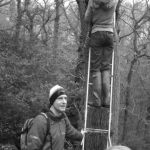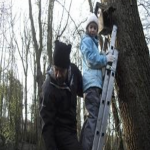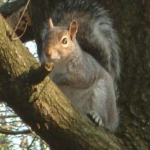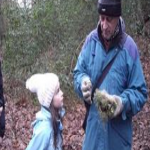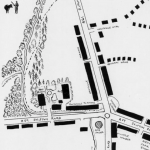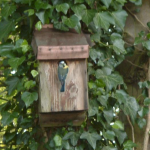The Bilton Conservation Group has been putting up and maintaining bird boxes throughout Nidd Gorge (Willow Woods, Sir Johns Wood, Bilton Beck Wood and Scotton Banks woodland) almost continuously since 1985.
In the early days the woodlands of the Nidd Gorge had a high proportion of conifers compared to native broad leaf trees (roughly 60:40 in places). The conifers offered little scope for birds generally and no prospects for those species which nest in holes – e.g. blue tit, coal tit, great tit, starling, nut hatch. With the exception of the east end of Sir John’s Wood where Bilton Beck flows into the river Nidd, many of the broadleaf trees are not mature enough to present birds with cracks and fissures where tree creepers, for example, prefer to nest.
So, to improve their prospects and help widen the diversity of species frequenting the gorge we have installed between 60 and 70 bird boxes. These are serviced late on each winter – when we clean out the previous year’s nest debris, record results and make running repairs. If the boxes are not cleaned out the birds will nest again but gradually a seething mass of parasites builds up. Some of the unwelcome strangers feed on the bird droppings and feathers others such as ticks and mites attach themselves to the birds and their young; sucking their blood and debilitating them. We fit special metal plates over the nest holes to deter predators such as woodpeckers and grey squirrels who would otherwise break in to eat the young birds and then set up home themselves!
Our records at the end of each season have shown a fairly steady pattern of success with 80% of the boxes being occupied and 70% showing signs of successful fledging. Where a box is not used we consider why and relocate it. The most frequent users appear to be blue tits and coal tits with occasional wrens, wasps, and bees!
2014 was a good year, 81.8% of the boxes had nests and 75% appeared to have fledged successfully. It is always sad to see evidence of the occasional tragedy with the mummified remains of a clutch of nestlings – beaks open, awaiting a life-saving beak full of caterpillars which failed to arrive – suggesting that Mum or Dad was waylaid perhaps by a passing sparrowhawk – but that is the way of the natural world. No wonder blue tits lay so many eggs, their mortality is so high they need to guarantee some survivors to perpetuate the species.
We feel our boxes are serving a useful purpose and even after the nesting season has ended there is evidence that they are used a lot for roosting during the cold weather (warmer perhaps than an exposed twig!).
Occasionally we put up bat roosting boxes which can provide summer quarters for species such as pippistrelles. The boxes are put up and left undisturbed as they require no cleaning out and it is illegal to inspect them. We have noticed that some years, quite perversely, the blue tits have used them by squeezing up the narrow climbing board!
These boxes are not a substitute for winter hibernacula however as bats when dormant during winter require very specialised conditions only found in caves and deep holes in trees.
Our plan is to extend the project into Grange Quarry, the small park owned by HBC, behind ‘Pets At Home’, New Park beside the Oak Beck. The stand of mature conifers is very like the Nidd Gorge woodlands of the 1980s and could benefit from a few carefully sited bird boxes to boost the prospects for small birds.
Gallery
